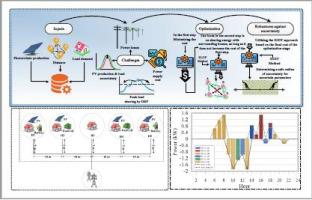Optimizing multi-objective peer-to-peer energy trading in green homes: Robust strategies to address non-probabilistic uncertainty using IGDT with integrated demand response
IF 7.1
2区 工程技术
Q1 CONSTRUCTION & BUILDING TECHNOLOGY
引用次数: 0
Abstract
Residential renewable energy systems, including Photovoltaic (PV), Energy Storage Systems (ESS), and hydrogen storage, are increasingly widespread, fostering a shift towards sustainable energy consumption. Peer-to-peer (P2P) energy trading emerges as a promising avenue for consumers to exchange self-generated renewable energy, promoting community resilience and green energy adoption. This study investigates the implications of P2P energy trading within microgrids, where homes are equipped with renewable sources and energy storage systems. Leveraging Information Gap Decision Theory (IGDT), we address uncertainties inherent in consumer demand and renewable energy generation, enhancing the robustness of microgrid operations. Through Sequential Linear Goal Programming (SLGP), we analyze case studies with and without P2P energy exchange, revealing diverse outcomes. P2P energy trading leads to a significant 17 % reduction in residential energy costs, stimulating the uptake of renewables and fostering local energy autonomy. Furthermore, strategic optimization of energy exchange pathways within the green homes yields a notable 20.5 % decrease in losses, enhancing overall system efficiency. Integrating demand response program (DRP) proves pivotal in reshaping energy consumption patterns, bolstering microgrid resilience, and mitigating residential expenses. These findings underscore the efficacy of DR in microgrid management, empowering communities with enhanced adaptability, load management capabilities, and energy reliability.

优化绿色住宅中的多目标点对点能源交易:利用集成需求响应的IGDT解决非概率不确定性的稳健策略
住宅可再生能源系统,包括光伏(PV)、储能系统(ESS)和储氢系统,日益普及,促进了向可持续能源消费的转变。点对点(P2P)能源交易成为消费者交换自主生产的可再生能源的一种有前景的途径,促进了社区的恢复能力和绿色能源的采用。本研究调查了微电网中P2P能源交易的影响,其中家庭配备了可再生能源和能源存储系统。利用信息差距决策理论(IGDT),我们解决了消费者需求和可再生能源发电固有的不确定性,增强了微电网运行的稳健性。通过序列线性目标规划(SLGP),我们分析了有和没有P2P能量交换的案例研究,揭示了不同的结果。P2P能源交易导致住宅能源成本显著降低17%,刺激了可再生能源的使用,并促进了地方能源自主。此外,绿色住宅内能源交换途径的战略优化显著降低了20.5%的损失,提高了整个系统的效率。整合需求响应计划(DRP)在重塑能源消费模式、增强微电网弹性和降低居民支出方面至关重要。这些发现强调了DR在微电网管理中的有效性,增强了社区的适应性、负荷管理能力和能源可靠性。
本文章由计算机程序翻译,如有差异,请以英文原文为准。
求助全文
约1分钟内获得全文
求助全文
来源期刊

Energy and Buildings
工程技术-工程:土木
CiteScore
12.70
自引率
11.90%
发文量
863
审稿时长
38 days
期刊介绍:
An international journal devoted to investigations of energy use and efficiency in buildings
Energy and Buildings is an international journal publishing articles with explicit links to energy use in buildings. The aim is to present new research results, and new proven practice aimed at reducing the energy needs of a building and improving indoor environment quality.
 求助内容:
求助内容: 应助结果提醒方式:
应助结果提醒方式:


